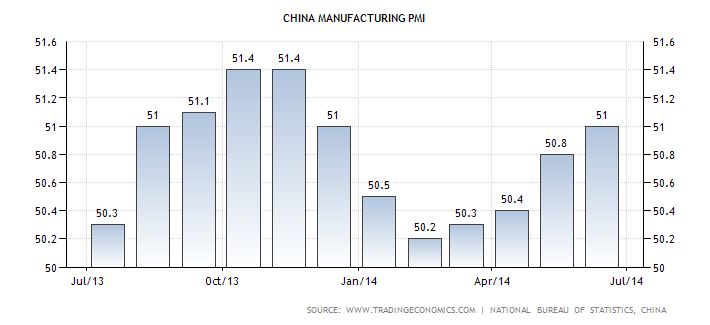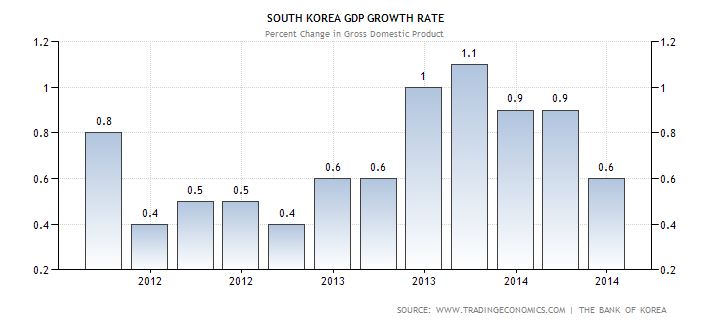Good news and bad news from three of our major export markets yesterday.
The July flash reading of the health of China’s manufacturing sector hit an18-month high, Japan’s trade deficit turned as exports unexpectedly fell and South Korean consumers stopped spending in the June quarter.
The news from China helped the Aussie dollar reach towards 94.50 US cents, after the earlier boost from the small rise in inflation in the June quarter.
China is our biggest export market, Japan is number two (but without the growth potential of China), so the markets tend to focus more on the flow of monthly data from the world’s second biggest economy.
And one of these is the twice a month reports on the health of Chinese manufacturing from HSBC/Markit. Yesterday’s first report for July (the final will be issued around August 1) surprised on the upside-that hasn’t happened for a while from China.
The so-called "flash" version of HSBC’s July manufacturing Purchasing Managers’ Index rose to 52.0, up from 50.7 in June, its consecutive second month back above the 50 level separating growth from contraction.
Now that was much better than forecasts of a reading of 51 and the rise was linked to better than forecast levels for new export orders and overall new orders rwhich ose at a faster rate than in the previous month, while employment slowed its decline.
"Economic activity continues to improve in July, suggesting that the cumulative impact of mini-stimulus measures introduced earlier is still filtering through," wrote HSBC chief China economist Hongbin Qu in his usual statement accompanying the report.
China PMI rebounding

But in Japan, news of another trade deficit wasn’t the headline, a surprise slowdown in exports was and that’s starting to gnaw at confidence about the current policy setting from the Government and the Bank of Japan which is partly based on a surge in exports helping pull the economy out of its funk, allied to higher inflation which busts the grip deflation has had over Japan for most of the past 25 years.
Japan reported that its trade deficit rose to Y822.2 billion ($US8.1 billion), narrowing slightly from May’s ¥911 billion deficit, but up sharp from the 180.8 billion yen in June 2013.
Exports fell 2.0% on year, while imports increased 8.4%.
The Finance Ministry data showed sales to Asia shrank 3.8%, shipments to India were down nearly 21% while there was a fall of 2.2% in exports to the US.
Surprisingly, given the tensions shipments to China rose 1.5%, a sign perhaps of the faster growth as shown by the ‘flash’ report on manufacturing
By commodity, shipments of audio parts and visual apparatus fell 21.4% year on year (the biggest drop), followed by mineral fuels (down 18.3%), medical products (down 15.5%), ships ( down 12.6%).
Exports of machinery slightly fell (0.4 %) thanks to sharp rises in the shipments of TVs (up 42%) and metal working machinery (up 27%).
On the other side, machinery imports jumped 14%, power generating equipment were up nearly 11% from a year ago, imports of manufactured goods rose 14%, imports of chemicals jumped 23% and raw materials rose 10.6%, driven by a 40% surge in the value of non ferrous ores imports.
Food imports jumped 10.1% and mineral fuel imports rose 8.3%, driven by shipments of petroleum products (LNG ) jumping 35% year on year.
Economists say the rise in imports is partly due to the higher level of imports to meet the undoubted rise in growth in Japan, but the main reason once again is the surge in LNG imports which jumped 31.6% year on year.
That’s because of the continuing closure of Japan’s 48 nuclear power plants (that excludes the six at Fukushima). That could start changing within the next couple of months with at least one station cleared to start powering up.
Another factor is that the rising value of the yen is starting to impact exports after being behind the big improvement seen in 2013 (July of last year saw the third highest level of exports in Japanese history, while there was an 18% rise in November of last year).
The 24 months of trade deficits is the longest since Japan’s statistics were reorganised back in the late 1970 into their current format (which started in 1979).
In South Korea saw a slowdown in second quarter growth as consumer stopped spending.
GDP in the three months to June rose 0.6%, down from 0.9% growth seen in the first three months of the year.
South Korea slows

That saw annual growth slow to 3.6% from 3.9%.
Household spending fell 1%, ending four consecutive quarters of growth.
A bright spot was a 7.7% rise (annual) in exports. Government spending rose 1.7%. Total consumption (private and government) fell half a per cent, after rising 0.6% in the first quarter.













